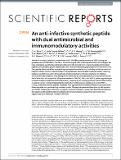An anti-infective synthetic peptide with dual antimicrobial and immunomodulatory activities
Author(s)
Silva, O. N.; Haney, E. F.; Fensterseifer, I. C. M.; Ribeiro, S. M.; Porto, W. F.; Faria-Junior, C.; Rezende, T. M. B.; Moreno, S. E.; Hancock, R. E. W.; Franco, O. L.; de la Fuente Nunez, Cesar; Lu, Timothy K.; Brown, Paul; ... Show more Show less
Downloadsrep35465.pdf (1.025Mb)
PUBLISHER_CC
Publisher with Creative Commons License
Creative Commons Attribution
Terms of use
Metadata
Show full item recordAbstract
Antibiotic-resistant infections are predicted to kill 10 million people per year by 2050, costing the global economy $100 trillion. Therefore, there is an urgent need to develop alternative technologies. We have engineered a synthetic peptide called clavanin-MO, derived from a marine tunicate antimicrobial peptide, which exhibits potent antimicrobial and immunomodulatory properties both in vitro and in vivo. The peptide effectively killed a panel of representative bacterial strains, including multidrug-resistant hospital isolates. Antimicrobial activity of the peptide was demonstrated in animal models, reducing bacterial counts by six orders of magnitude, and contributing to infection clearance. In addition, clavanin-MO was capable of modulating innate immunity by stimulating leukocyte recruitment to the site of infection, and production of immune mediators GM-CSF, IFN-γ and MCP-1, while suppressing an excessive and potentially harmful inflammatory response by increasing synthesis of anti-inflammatory cytokines such as IL-10 and repressing the levels of pro-inflammatory cytokines IL-12 and TNF-α. Finally, treatment with the peptide protected mice against otherwise lethal infections caused by both Gram-negative and -positive drug-resistant strains. The peptide presented here directly kills bacteria and further helps resolve infections through its immune modulatory properties. Peptide anti-infective therapeutics with combined antimicrobial and immunomodulatory properties represent a new approach to treat antibiotic-resistant infections.
Date issued
2016-11Department
MIT Synthetic Biology Center; Massachusetts Institute of Technology. Department of Biological Engineering; Massachusetts Institute of Technology. Department of Chemical Engineering; Massachusetts Institute of Technology. Department of Electrical Engineering and Computer Science; Massachusetts Institute of Technology. Research Laboratory of ElectronicsJournal
Scientific Reports
Publisher
Springer Nature
Citation
Silva, O. N., C. de la Fuente-Núñez, E. F. Haney, I. C. M. Fensterseifer, S. M. Ribeiro, W. F. Porto, P. Brown, et al. “An Anti-Infective Synthetic Peptide with Dual Antimicrobial and Immunomodulatory Activities.” Scientific Reports 6 (November 2, 2016): 35465.
Version: Final published version
ISSN
2045-2322